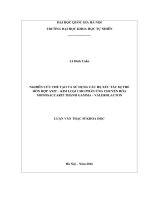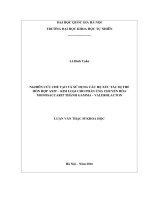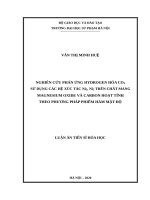Nghiên cứu phản ứng hydrogen hóa CO2 sử dụng các hệ xúc tác ni5, ni5 trên chất mang magnesium oxide và carbon hoạt tính theo phương pháp phiếm hàm mật độ tt tiếng anh
Bạn đang xem bản rút gọn của tài liệu. Xem và tải ngay bản đầy đủ của tài liệu tại đây (316.28 KB, 32 trang )
MINISTRY OF EDUCATION AND TRAINING
HANOI UNIVERSITY OF EDUCATION
VAN THI MINH HUE
THEORETICAL STUDY OF CO2 HYDROGENATION
OVER Ni5, Ni5/MgO, Ni5/AC CATALYSTS
USING DENSITY FUNCTIONAL THEORY
Specialization: Theoretical and Physical Chemistry
Code: 9.44.01.19
SUMMARY OF CHEMICAL PhD THESIS
HA NOI - 2020
1
The thesis was completed at: Department of Chemistry - Hanoi
University of Education
Scientific Instructors:
Assoc. Prof. NGUYEN NGOC HA
Review 1: Prof. Dr. Lâm Ngọc Thiềm-Hanoi University of Science,
VNU
Review 2: Prof. Dr. Trần Đại Lâm-Institute for Tropical Technology
Review 3: Assoc. Prof. Dr. Nguyễn Thị Minh Huệ-Hanoi National
University of Education.
The thesis will be presented before the Board of thesis review at
Hanoi University of Education on .....h..... day..... month ... year...
The thesis can be found at: National Library, Hanoi or the library of
Hanoi National University of Education
2
LIST OF WORKS PUBLISHED BY AUTHOR
1. Văn Thị Minh Huệ, Nguyễn Ngọc Hà ( 2015), “Nghiên cứu sự hấp phụ
CO2 và H2 trên cluster Ni5 bằng phương pháp phiếm hàm mật độ”, Tạp chí
Xúc tác và Hấp phụ, T4(1), Tr.23-28.
2. Van Thi Minh Hue, Nguyen Ngoc Ha (2016), “–HCOO and –HOCO
formations from CO2 on Ni5 cluster and Ni5/MgO(200): a theoretical study”,
The 6th International Conference “Chemical Thermodynamics and
Kinetics”, Tver, Russia, 31st May – 3rd June.
3. Văn Thị Minh Huệ, Bùi Công Trình, Nguyễn Thị Thu Hà, Nguyễn Ngọc
Hà (2018), “Nghiên cứu phản ứng methane hóa CO 2 trên xúc tác cluster Ni5
bằng phương pháp phiếm hàm mật độ”, Tạp chí hóa học, 56, 6e2, Tr.194198.
4. Nguyen Thi Thu Ha, Van Thi Minh Hue, Bui Cong Trinh, Nguyen Ngoc
Ha, and Le Minh Cam (2019), “Study on the Adsorption and Activation
Behaviours of Carbon Dioxide over Copper Cluster (Cu 4) and AluminaSupported Copper Catalist (Cu4/Al2O3) by means of Density Functional
Theory”, Journal of Chemistry, vol. 2019, Article ID 4341056, 10 pages.
5. Văn Thị Minh Huệ, Nguyễn Thị Thu Hà, Phùng Thị Lan, Lê Minh Cầm,
Nguyễn Ngọc Hà (2020), “Nghiên cứu lí thuyết phản ứng methane hóa CO 2
trên xúc tác Ni5/AC bằng phương pháp phiếm hàm mật độ. Phần I : Giai
đoạn hấp phụ và hoạt hóa”, Tạp chí Xúc tác và Hấp phụ, 9(1), Tr.33-38.
6. Văn Thị Minh Huệ, Nguyễn Thị Thu Hà, Phùng Thị Lan, Lê Minh Cầm,
Nguyễn Ngọc Hà (2020), “ Nghiên cứu lí thuyết phản ứng methane hóa CO 2
trên xúc tác Ni5/AC bằng phương pháp phiếm hàm mật độ. Phần II : Các
đường phản ứng”, Tạp chí Xúc tác và Hấp phụ, 9(1), Tr.74-81.
3
4
INTRODUCTION
1. The reason for choosing topic
Nowadays, the concentration of carbon dioxide in the atmosphere has
consequently risen. The increase in CO 2 emissions arguably contributes to
the increase in global temperatures and climate changes due to the
‘‘greenhouse effect’’. However, carbon dioxide is also a cheap, safe source
of carbon. This gas can be converted into many organic compounds with
important applications such as CH4, CH3OH, HCHO, HCOOH... when
suitable catalysts are available.
In most of the studies, nickel-based catalysts were chosen because of
their higher CO2 conversion in terms of activity and selectivity, and cheaper
compared to noble metal-based catalysts.
The study of CO2 conversion catalyst using nano-sized nickel metal on
the support is expected to be a good catalyst, making CO 2 conversion easier
but there have not been many studies on catalysis. Continuing research on
carbon dioxide conversion is essential.
For the reasons mentioned above, we select the research problem:
“Theoretical study of CO2 hydrogenation over Ni5, Ni5/MgO, Ni5/AC
catalysts using density functional theory”.
2. Research purpose and tasks
a) Purpose: Using the density functional method (DFT) to find out the
mechanism of CO2 hydrogenation reaction, the main product, by-products,
the optimal reaction path, compare and evaluate the catalytic ability of the
Ni5 cluster, Ni5/MgO, and Ni5/AC.
b) Tasks: Overall document review for the theoretical basis of related
quantum chemical problems. Research situation to convert CO by
theoretical and empirical methods in the country and in the world.
- Calculate to build reaction paths that occur in each system, evaluation
and comparison of the operability, and selectivity of the catalysts.
3. Scope and object of the study
- Molecules: CO2, H2, CH4, HCHO, HCOOH, CH3OH.
- Catalysts: Ni5, Ni5/MgO, Ni5/AC.
4
5
4. Scientific and practical significance of the thesis
The conversion of CO2 with H2 is not only a reduction of CO 2 but also
economical when converting CO2 into useful products. Using theoretical
calculations by modern and good approximation methods to find out the
mechanism of hydrogenation CO2 over Ni5 based catalyst. This will help
guide empirical research in the selection of suitable catalysts and supports.
5. New points of the thesis
- The adsorption of H2 on Ni5 is dissociated. CO2 adsorption is chemically
adsorbed and CO2 is strongly activated. When placed on the supports, the
capacity of Ni5 decreases due to the decrease in charge density;
- Calculated the mechanism of CO2 hydrogenation to form CH4, CH3OH,
HCHO, and HCOOH over Ni 5, Ni5/MgO, and Ni5/AC including 33 reaction
paths, building potential energy surfaces, and consider reaction mechanisms.
- On the three catalyst Ni5, Ni5/MgO and Ni5/AC, CH4 is the most preferred
CO2 hydrogenation product. The reaction path that forms the optimal CH 4 is
the reaction path that passes through intermediate products such as HOCO,
CO, HCO, H2COH, etc. (CO route); identified the step that determines the
reaction rate in the hydrogenation of CO2 on the above catalysts;
- Explained that MgO and AC not only act as supports but also change the
electron structure of the metal cluster, leading to changes in activation and
reaction mechanism.
6. The layout of the thesis
Introduction: Introducing the reasons for choosing the topic, the
purpose, and scope of the research, the new points of the thesis, the
scientific and practical significance of the thesis.
Chapter 1: Introduce the theoretical basis including the problems of
quantum chemical theory.
Chapter 2: Overview of the research system and method of calculation.
Chapter 3: Research results and discussion.
Conclusion: Briefly summarize the results of the thesis.
5
6
Chapter 1. THEORY BASIS
Introduce the density functional theory: Schrödinger equation,
Hohenberg-Kohn theorems, exchange-correlation approximations, the CINEB method determines the transition state.
Chapter 2. LITERATURE REVIEW
2.1. Overview of hydrogenation CO2 reaction
The thermodynamic stability of CO2 requires high energy
substances for its transformation into valuable chemicals in
which the carbon atom has a lower oxidation state than 4.
Hence, it is highly crucial to employ suitable catalysts which
can decrease the energy barriers, thus resulting in lower
energy states of the system.
2.2. Catalytic CO2 hydrogenation CO2: Overview
Due to the structure of CO 2 molecule, to weaken the C=O bond, it is
often used as a transition metal, in which Ni-based catalysts are commonly
used in industrial purposes due to its good activity, high selectivity and high
availability so the price is cheap.
There have been some theoretical and empirical studies on the CO2
conversion reaction over nickel-based catalysts but mainly on crystal nickel
catalysts, very few studies on nano-sized catalysts.
2.3. Research in the country and in the world
6
7
Although the methanation of CO2 is a comparatively simple
reaction, its reaction mechanism appears to be difficult to
establish. There are different opinions on the nature of the intermediate
formation process. Reaction mechanisms proposed for CO 2 methanation fall
into two main categories. The first one involves the conversion of CO 2 to
CO prior to methanation, and the subsequent reaction follows the same
mechanism as CO methanation. The other one involves the direct
hydrogenation of CO2 to methane without forming CO as intermediate.
Even for CO methanation, there is still no consensus on the kinetics and
mechanism. The theoretical studies of cluster catalysts, especially the
cluster placed on the supports are still limited. Therefore, more theoretical
studies on this issue are needed to clearly understand the reaction
mechanism, in order to guide empirical studies to synthesize suitable
catalysts.
2.4. Method of calculation
All the geometry and energy calculations were performed using the
density functional theory (DFT) approach. The generalized gradient
approximation (GGA) with the Perdew, Burke, and Ernzerhof (PBE)
nonlocal gradient-corrected functional was employed to estimate the
exchange-correlation energy. The double zeta basis plus polarization
orbitals (DZP) was used for valence electrons, while the core electrons were
treated using the norm-conserving pseudopotentials (NCP) in its fully
nonlocal (Kleinman-Bylander) form. The Coulomb potential was expanded
in a plane-wave basis with an energy cut-off of 2040,75eV. The sizes of the
simulation box were 25×25×25 (Å 3). The DFT calculations were performed
using the SIESTA code due to its accuracy. The transition states were
determined by using the climbing image nudged elastic band (CI-NEB)
method.
Chapter 3: RESULTS AND DISCUSSION
3.1. Computational model
7
8
In this thesis, we have built computational models including molecular
molecules (CO2, H2 and Ni5 cluster), MgO (200), AC; Ni5 on MgO (200), and
AC; Intermediate products and transition states of phases in CO2 hydrogenation
reaction paths on the catalytic surfaces of Ni5, Ni5/MgO, Ni5/AC.
3.2. CO2 hydrogenation reaction on Ni5 catalyst
3.2.1. Ni5 structure
In this study, we chose Ni5 because this is the smallest cluster that can
comprehensively study isomers, Ni5 can be considered to be stable and
existent.
The calculation results show that the two most stable structures of the
Ni5 cluster are square pyramid and trigonal bipyramid. The trigonal
bipyramid isomers are more stable than the square pyramid. This result
agrees with some previous theoretical and empirical studies on the structure
of Ni clusters.
3.2.2. Adsorption of CO2 and H2 on Ni5
- Adsorption of H2 on Ni5: In the most
stable adsorption configurations, H2 is
dissociated into H, Eads=−243,9kJ.mol−1.
The result of CI-NEB calculation shows E a Figure 3.1. Adsorption
= 0.
configuration of H2 over Ni5
- Adsorption of CO2 on Ni5:
The most stable adsorption configuration
is multi-center adsorption on 2 Ni atoms
with Eads=−249,7 kJ.mol−1, Ea=0. This is a
chemical adsorption.
8
Figure
3.3.
Adsorption
configuration of CO2 over Ni5
9
3.2.3. Reaction paths on Ni5 catalyst
The calculated mechanisms are summarized in Figure 3.6.
-
-
Figure 3.6. The calculated reaction pathways of CO2 hydrogenation over Ni5
Based on the proposed reaction diagram, we can provide the following
reaction pathways:
Carbon monoxide formation on Ni5 catalyst:
P1-CO/Ni5: R1→R4→R10;
P2-CO/Ni5: R3→R7→R11.
-Methane formation on Ni5 catalyst:
P1-CH4/Ni5: R1→R4→R10→R15→R18→R22→R28→R29
P2-CH4/Ni5: R1→R4→R10→R15→R19→R24→R32→R37→R38
P3-CH4/Ni5: R1→R4→R10→R15→R18→R23→R23’→R32→R37→R38
P4-CH4/Ni5: R1→R4→R10→R15→R19→R25→R33→R37→R38
P5-CH4/Ni5: R1→R4→R10→R16→R21→R26→R34→R37→R38
P6-CH4/Ni5: R1→R4→R10→R16→R21→R27→R35→R37→R38
Methanol formation on Ni5 catalyst:
9
10
P1-CH3OH/Ni5: R1→R4→R10→R15→R18→R22→R30
P2-CH3OH/Ni5: R1→R4→R10→R15→R19→R24→R31
P3-CH3OH/Ni5: R1→R4→R10→R15→R18→R23→R23’→R31
P4-CH3OH/Ni5: R1→R4→R10→R16→R21→R27→R36
- Formaldehyde formation on Ni5 catalyst:
P-HCHO/Ni5: R1→R4→R10→R15→R18
-Formic acid formation on Ni5 catalyst:
P-HCOOH/Ni5: R2→R6
- Coke formation on Ni5 catalyst:
P-C/Ni5: R1→R4→R10→R16→R20.
The corresponding energies and activation energies values of the steps
are shown in Table 3.9.
Table 3.9. Corresponding energy (∆E), activated energy (Ea)
of the reaction steps on Ni5
10
11
Step
R1
R2
R2’
R3
R4
R5
R6
R7
R8
R9
R9’
R10
R11
R12
R13
R14
R15
R16
R17
R18
R19
R20
R21
R22
R23
R23’
R24
R25
R26
R27
R27’
R28
R29
R30
R31
R32
R33
R34
R35
R36
R37
11
Reaction
Oa=C=Ob +Ha → HaOaCOb
Oa=C=Ob +Ha → HaCOaOb
R2 transposition
Oa=C=Ob → COb + Oa
HaOaCOb→HaOa +COb
HaCOaOb+Hb→HbHaCOaOb
HaCOaOb+Hb→HaCOaObHb
COb + Oa +Ha →HaOa +COb
COb + Oa +Ha →Oa +CObHa
COb + Oa +Ha →Oa +HaCOb
R9 transposition
HaOa+COb+Hb→COb+HaOaHb
HaOa+COb+Hb→COb+HaOaHb
Oa +HaCOb+Hb →OaHb +HaCOb
Oa +HaCOb +Hb→Oa +HbHaCOb
Oa +HaCOb+Hb →Oa +HaCObHb
COb+Hc→HcCOb
COb+Hc→CObHc
COb→C+Ob
HcCOb+Hd→HcHdCOb
HcCOb+Hd→HcCObHd
CObHc +Hd→HdObHc + C
CObHc +Hd→HdCObHc
HcHdCOb+He→HeHcHdCOb
HcHdCOb+He→HcHdCObHe
R23 transposition
HcCObHd+He→HeHcCObHd
HcCObHd+He→CHc+HeObHd
HdCObHc+He→CHd+HeObHc
HdCObHc+He→HeHdCObHc
R27 transposition
HeHcHdCOb→HeHcHdC+Ob
HeHcHdC+Ob+Hf→HfHeHcHdC+Ob
HeHcHdCOb+Hf→HeHcHdCObHf
HeHcCObHd+Hf→HfHeHcCObHd
HeHcCObHd+Hf→CHeHc+HfObHd
CHc+Hf→CHcHf
CHd+Hf →CHfHd
HeHdCObHc+Hf→HeHdC+ HfObHc
HeHdCObHc+Hf→HfHeHdCObHc+Hf
CHcHf +Hg→ CHcHfHg
Ea, kJ.mol−1
71.7
88.1
133.0
56.1
183.8
124.8
53.1
138.6
37.3
89.7
167.8
131.0
145.0
106.5
126.5
288.1
74.4
86.0
295.7
69.3
8.1
111.5
43.3
12.0
103.3
83.5
12.1
45.1
57.3
112.3
206.0
145.5
74.0
63.6
97.0
56.9
85.4
52.9
ΔE, kJ.mol−1
26.6
63.2
−120.2
12.3
−75.4
113.6
83.2
−140.2
101.2
−12.5
25.0
80.2
139.2
−25.6
69.5
92.4
59.6
85.9
146.3
44.7
59.2
161.9
−10.6
−50.0
20.5
−26.8
−47.1
0.0
−134.1
−47.1
23.8
0.8
102.1
117.1
50.4
15.0
−59.5
18.3
−61.7
33.9
−30.8
12
Step
R38
12
Reaction
CHcHfHg +Hh→CHcHfHgHh
Ea, kJ.mol−1
ΔE, kJ.mol−1
80.5
69.8
13
In the following sections, we detailed analysis of calculation results for
each reaction path.
3.2.3.1. Carbon monoxide formation on Ni5 catalyst
The most optimal reaction of the two paths forming CO is P1-CO/Ni 5.
The highest Ea value of this path is 71.7 kJ.mol−1 for the R1 step.
3.2.3.2. Methane formation on Ni5 catalyst
The most optimal reaction of the six paths forming CH 4 is the P2CH4/Ni5 reaction path. The highest Ea value of this path is 106.5 kJ.mol−1 for
the formation of HCO in the R15 step.
3.2.3.3. Methanol formation on Ni5 catalyst
The most optimal reaction of the four paths forming CH3OH is P3CH3OH/Ni5, with the highest Ea of 126.5 kJ.mol−1, while the other paths
have Ea value of 145.5 and 206.0 kJ.mol−1 respectively.
3.2.3.4. Formaldehyde formation on Ni5 catalyst
This reaction path is part of the P1-CH4/Ni5. HCHO formation is
feasible. The highest Ea value of this path is 106.5 kJ.mol−1.
3.2.3.5. Formic acid formation on Ni5 catalyst
This reaction path has only two reaction steps, in which the R6 step has
the highest Ea value, Ea = 124.8 kJ.mol−1.
3.2.3.6. Coke formation on Ni5 catalyst
The formation of carbon (coke) is unlikely because the highest E a in this
reaction path is 295.7 kJ.mol−1.
The potential energy surface for the proposed reaction mechanism on
the Ni5 catalyst shown in Figure 3.8 and Figure 3.9.
13
14
Figure 3.8. The potential energy surface of the reaction steps between CO2
and Ha, Hb on Ni5
Figure 3.9. The potential energy surface from R15 to R38 step of
conversion reaction on Ni5
According to our calculation results, on Ni5 catalysts, the main product is
methane via the CO route. This result is in agreement with experimentation,
experimental studies have shown that nickel-based catalysts for productoriented catalysis are CH4. The highest activation energy is 106.5 kJ.mol−1
from the hydrogenation CO into HCO so the elementary reaction H+CO →
HCO is the rate-determining step. When the reaction occurs at high
temperatures, the by-products are CH3OH, CO, HCHO, HCOOH.
14
15
3.3. CO2 hydrogenation reaction on Ni5/MgO catalyst
3.3.1. Ni5/MgO structure
MgO is good support for nickel catalysts; MgO is a Lewis base, it will
increase CO2 absorption and reduce or inhibit carbon formation by adsorbing
high concentrations of CO2 on the surface of the catalyst. In this thesis, the
Ni5 cluster is placed on the surface of MgO(200), corresponding to the highest
pick on the XRD diagram according to calculations and experiments.
A two-layer with 41 molecules of MgO was chosen to represent the
MgO(200) surface. The number of atoms and the number of layers is chosen
to ensure the best possible simulation of the possible interactions between
MgO and gas molecules but not too large as this will increase the
computational cost. Then Ni5 cluster of trigonal bipyramid and square
pyramid is placed on the surface of MgO(200) and optimized. The results
show that in the most stable geometric structure, the Ni 5 cluster has a structure
close to the square pyramid. The ∆E of this process is very negative (–512.8
kJ.mol−1) proving that this structure is stable. In the next steps, we investigate
the hydrogenation of CO2 on Ni5 in the square-pyramid shaped.
3.3.2. Adsorption of CO2 and H2 on Ni5MgO
15
16
-
Adsorption
of
H2
on
Ni5MgO:
Adsorption configuration of 2.1a1 is the
most stable. H2 molecule is dissociated
into H, Eads=−250,6kJ.mol−1, Ea = 0.
- Adsorption of CO2 on Ni5/MgO: The
Figure 3.16. Adsorption
configuration of H2 over Ni5/MgO
most stable structure has Eads=−224,3
kJ.mol−1, Ea=0, corresponding to multicenter adsorption on 2 Ni atoms. After
adsorption,
activated.
16
the
CO2
molecule
is
Figure 3.17. Adsorption
configuration of CO2 over Ni5/MgO
17
Another possibility to consider is the adsorption of CO 2 and H2 onto the
MgO support. The calculation results show that the most stable absorption
of CO2 and H2 were −105,3 kJ.mol−1 and –44.9 kJ.mol−1. Compared CO2
adsorption energy on MgO and nickel, it was observed that it is more
favorable for CO2 activation on the nickel surface. The adsorption on the
cluster is more preferred on MgO, MgO only acts as a support. The
adsorbed CO2 molecule on the Ni5 cluster is stronger than the Ni5 cluster
adopted on MgO. The results of Cu4 adsorption on the Al2O3 support also
showed similar results, the adsorption on Cu 4 cluster (Eads = −150,49
kJ.mol−1) was stronger than on Cu4/Al2O3 (Eads= −87,15 kJ.mol−1).
3.3.3. Reaction paths on Ni5/MgO catalyst
The calculated mechanisms are summarized in Figure 3.22.
Figure 3.22. The calculated reaction pathways of CO2 hydrogenation over
Ni5/MgO
Based on the proposed reaction diagram, we can provide the following
reaction pathways:
-
Carbon monoxide formation on Ni5/MgO catalyst:
17
18
-
-
P1-CO/Ni5MgO: R1→R4→R10, P2-CO/Ni5MgO: R3→R7→R7’→R10.
Methane formation on Ni5/MgO catalyst:
P1-CH4/Ni5MgO: R1→R4→R10→R11→R14→R17→R17’→R22→R23→R24
P2-CH4/Ni5MgO: R1→R4→R10→R11→R14→R18→R21→R25
Methanol formation on Ni5/MgO catalyst:
P1-CH3OH/Ni5MgO: R1→R4→R10→R11→R14→R17→R19
P2-CH3OH/Ni5MgO: R1→R4→R10→R11→R14→R18→R20
- Formaldehyde formation on Ni5/MgO catalyst:
P-HCHO/Ni5MgO: R1→R4→R10→R11→R14
-Formic acid formation on Ni5/MgO catalyst:
P-HCOOH/Ni5MgO: R2→R6
- Coke formation on Ni5/MgO catalyst:
P-C/Ni5MgO: R1→R4→R10→R12→R16
The corresponding energy and activation energy values of the steps are
shown in Table 3.18.
Table 3.18. Corresponding energy (∆E), activated energy (Ea)
of the reaction steps on Ni5/MgO
18
19
Step
Reaction
Ea, kJ.mol1
ΔE, kJ.mol-1
R1
Oa=C=Ob +Ha → HaOaCOb
128.7
117.8
R2
Oa=C=Ob +Ha → HaCOaOb
199.7
97.1
R3
Oa=C=Ob → Oa +COb
172.0
133.9
R4
HaOaCOb→HaOa +COb
-
−114.5
R5
HaCOaOb+Hb→HbHaCOaOb
334.1
139.1
R6
HaCOaOb+Hb→HaCOaObHb
263.2
250.4
R7
Oa +COb + Ha→HaOa +COb
46.8
−152.2
R7’
R7 transposition
-
−60.0
R8
Oa +COb + Ha→Oa +HaCOb
120.4
76.6
R9
Oa +COb + Ha→Oa +CObHa
243.6
180.8
R10
HaOa+COb+Hb→COb+HaOaHb
142.0
88.5
R11
COb+Hc→HcCOb
97.0
49.0
R12
COb+Hc→CObHc
256.8
215.4
R13
COb→C+Ob
243.7
1.5
R14
HcCOb+Hd→HcHdCOb
75.2
21.3
R15
HcCOb + Hd → HcCObHd
223.0
148.2
R16
CObHc+Hd→C+HdObHc
27.8
−47.4
R17
HcHdCOb+He→HcHdCObHe
34.6
−67.6
R18
HcHdCOb+He→HeHcHdCOb
12.3
−74.9
R17’
R17 transposition
52.5
51.2
R19
HcHdCObHe+Hf→HfHcHdCObHe
97.1
35.0
R20
HeHcHdCOb+Hf→HeHcHdCObHf
192.0
151.8
R21
HeHcHdCOb→HeHcHdC+Ob
152.2
30.0
R22
HcHdCObHe+Hf→HcHdC+HfObHf
-
−34.2
R23
HcHdC+Hg→HcHdC+Hg
42.6
−28.3
R24
HcHdCHg+Hf→HcHdCHgHf
87.8
68.6
R25
HeHcHdC+Ob+Hf→HfHeHcHdC(CH4)
139.1
87.9
+Ob
In the following sections, we detailed analysis of calculation results for each
reaction path.
19
20
3.3.3.1. Carbon monoxide formation on Ni5/MgO catalyst
The most optimal reaction of the two paths forming CO is P1CO/Ni5MgO. The highest Ea value of this path is 142.0 kJ.mol −1 for the R10
step: CO+OH+ H→ CO+H2O.
20
21
3.3.3.2. Methane formation on Ni5/MgO catalyst
The most optimal reaction of the two paths forming CH4 is the P2CH4/Ni5MgO reaction path. The highest Ea value of this path is 152.2
kJ.mol−1 for the R10 step.
3.3.3.3. Methanol formation on Ni5/MgO catalyst
The most optimal reaction of the two paths forming CH 3OH is P1CH3OH/Ni5MgO reaction path. The highest Ea value of this path is 142.0
kJ.mol−1 for the R10 step.
3.3.3.4. Formaldehyde formation on Ni5/MgO catalyst
The reaction steps in this pathway are part of the P1-CH 4/Ni5MgO.
HCHO formation is feasible because of the step with the highest E a in this
reaction path is 142.0 kJ.mol−1.
3.3.3.4. Formic acid formation on Ni5/MgO catalyst
The formation of HCOOH is not favorable on kinetics and
thermodynamics because of Ea= 263.2 kJ.mol−1 and ∆E = 250.4 kJ.mol−1.
3.3.3.5. Coke formation on Ni5/MgO catalyst
Coke formation is unfavorable because of the R12 step has very high E a
and ∆E. According to our opinion, it is not possible to create coke on
Ni5/MgO.
After a detailed analysis of the reaction paths, we constructed the
potential energy surface for the proposed reaction mechanism on the
Ni5/MgO catalyst shown in Figure 3.23 and Figure 3.24.
21
22
Figure 3.23. The potential energy surface of the reaction steps between
CO2 and Ha, Hb on Ni5/MgO
Figure 3.24. The potential energy surface from R11 to R25 of
conversion reaction on Ni5/MgO
22
23
Mechanism analysis shows that the CO2 hydrogenation reaction on
Ni5/MgO catalyst, conversion of CO2 to CO prior to methanation (involving
a CO intermediate). On the potential energy surface, CH4 is more stable
than CH3OH. The reaction path that forms CH4 is also more favorable, so on
the Ni5/MgO catalyst, the hydrogenated CO2 reaction creates the main
product CH4 through the P2-CH4/ Ni5MgO reaction path. On this path, the
reaction step has the highest activation energy of 152.2 kJ.mol –1 for step
CH3O*→CH3*+O*, so this step is expected to determine the reaction rate.
The conversion of CO2 into methane by the proposed mechanism is
considered feasible. The possible by-products are CO, HCHO, and CH3OH.
3.4. CO2 hydrogenation reaction on Ni5/AC
Activated carbon (AC) is the support of interest due to its many
properties: large specific surface area, low cost, capillary structure, easy
surface modification, etc. Loading Ni5 on the AC surface is expected to be a
good catalyst for the hydrogenation of CO2.
3.4.1. Ni5/AC structure
Simulation of activated carbon (AC) with a hexagonal arrangement of
carbon ring, referenced from empirical data. The selected AC model is C 72,
which is large enough for the reactions to occur on the surface of the AC but
not too large because it will increase the computational cost. Calculation
results show that in the most stable geometric structure, the Ni 5 cluster has a
structure close to the square pyramid. The results of charge analysis, bond
order, spin polarization, HOMO images show that the interaction between
Ni5 and AC can be considered as chemical adsorption due to the formation
of Ni−C bonds.
3.4.2. Adsorption of CO2 and H2 on Ni5/AC
23
24
- Adsorption of H2 on Ni5/AC: The
most stable adsorption configuration
is 3.1a with absorption energy
−240,8 kJ.mol−1, Ea=0.
Figure 3.29. Adsorption
configuration of H2 over Ni5/AC
- Adsorption of CO2 on Ni5/AC: The
most stable adsorption configuration
is 3.1b1 with Eads=−219,0 kJ.mol−1,
Ea=0 - corresponding to the multicenter
24
Figure 3.30. Adsorption
configuration of CO2 over Ni5/AC
25
chemical adsorption on two different Ni atoms on the bottom of the square pyramid.
The adsorption of CO2 and H2 on AC showed that corresponding to the
most durable adsorption structures, the adsorption energy was −27.7
kJ.mol−1 and −15.0 kJ.mol−1, respectively. After adsorption on AC, CO2 and
H2 molecules do not change significantly compared to free molecules. The
adsorption of CO2 and H2 on AC is much less favorable than adsorption on
Ni5/AC.
3.4.3. Reaction paths on Ni5/AC catalyst
The calculated mechanisms are summarized in Figure 3.33.
Figure 3.33. The calculated reaction pathways of CO2 hydrogenation over
Ni5/AC
Based on the proposed reaction diagram, we can provide the following
reaction pathways:
-
Carbon monoxide formation on Ni5AC catalyst:
P1-CO/Ni5AC: R1→R4→R11; P2-CO/Ni5AC: R3→R8→R11.
-
Methane formation on Ni5AC catalyst:
P1-CH4/Ni5AC: R3→R8→R11→R15→R18→R22→R24→R26→R27
P2-CH4/Ni5AC: R3→R8→R11→R15→R18→R22→R25→R30
25









